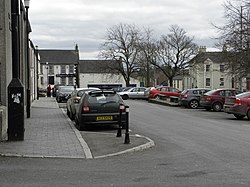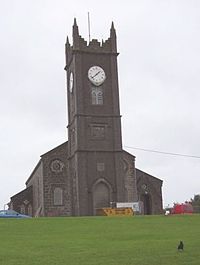Moy, Tyrone
| Moy | |
| Tyrone | |
|---|---|

| |
| Location | |
| Grid reference: | H7962 |
| Location: | 54°26’49"N, 6°41’31"W |
| Data | |
| Population: | 2,129 (2011) |
| Post town: | Dungannon |
| Postcode: | BT71 |
| Dialling code: | 02887789/84 |
| Local Government | |
| Council: | Mid-Ulster |
| Parliamentary constituency: |
Fermanagh and South Tyrone |
| Website: | www.moyni.weebly.com |
Moy, known locally as The Moy is a Large Village and townland in Tyrone about 5 miles southeast of Dungannon, beside the smaller village of Charlemont. Charlemont is on the east bank of the River Blackwater and Moy on the west; the two are joined by Charlemont Bridge. The river is also the boundary between the two counties of Tyrone and Armagh.
The 2011 Census recorded a population of 2,129.
The name of the village is from the Irish an Maigh, meaning "The Plain".[1]
History
Moy was laid out in the 1760s for the Volunteer Earl – the aesthete James Caulfield, 1st Earl of Charlemont (1728-1799) – opposite Charlemont Fort across the Blackwater. The formal rectangular market place, with lawns and horse-chestnut trees, was inspired by the square at Bosco Marengo in Lombardy, admired by the young earl during his grand tour of Europe. The houses lining the village square are mostly mid-18th century, though all four churches (Church of Ireland, Presbyterian, Methodist and Roman Catholic) are later. Moy used to hold a great horse fair, held once a month and lasting a whole week.
For a small place, Moy suffered badly in the Troubles, and 11 men and women, both Protestant and Roman Catholic, were murdered.
The Portadown – Dungannon section of the Portadown, Dungannon and Omagh Junction Railway (PD&O) opened in 1858.[2] Its nearest station to Moy was optimistically called 'Trew and Moy', although it was at Trew Mount over 2 miles north of Moy. In 1876 the PD&O became part of the new Great Northern Railway.[3] The Ulster Transport Authority took over the line in 1958[4] and closed it in 1965.[5]
Places of interest
Moy features a cast-iron gate and screen set up in the 19th century to provide the grand entrance to the now-vanished Roxborough Castle. The richly modelled metalwork is thought by some to have been the work of the company of the celebrated Dublin iron-founder Richard Turner, best known for his conservatories in Dublin, Belfast and Kew Gardens.
Sport
Moy has a long history of horse riding and Gaelic games.
Outside links
| ("Wikimedia Commons" has material about Moy, Tyrone) |
References
- ↑ "Placenames NI". Placenames NI. 2010-01-20. http://www.placenamesni.org/resultsdetail.phtml?entry=10017. Retrieved 2012-06-09.
- ↑ Hajducki, S. Maxwell (1974). A Railway Atlas of Ireland. Newton Abbott: David & Charles. map 8. ISBN 0-7153-5167-2.
- ↑ Hajducki, op. cit., page xii
- ↑ Hajducki, op. cit., page xiii
- ↑ Baker, Michael H.C. (1972). Irish Railways since 1916. London: Ian Allan. pp. 155, 209. ISBN 0 7110 0282 7.
